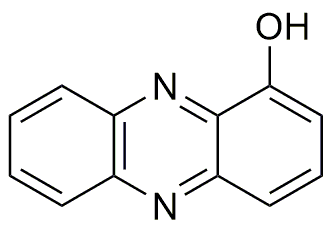1-Hydroxyphenazine is widely utilized in research focused on:
- Electrochemical Sensors: This compound is used to develop sensitive electrochemical sensors for detecting various analytes, including heavy metals and biomolecules, enhancing environmental monitoring and healthcare diagnostics.
- Photodynamic Therapy: In the medical field, it serves as a photosensitizer in photodynamic therapy for cancer treatment, where it helps to selectively destroy cancer cells upon light activation, minimizing damage to surrounding healthy tissue.
- Organic Electronics: 1-Hydroxyphenazine is applied in organic electronic devices, such as organic light-emitting diodes (OLEDs), due to its excellent charge transport properties, leading to more efficient and brighter displays.
- Antioxidant Research: It is studied for its antioxidant properties, contributing to the development of new formulations in cosmetics and dietary supplements aimed at combating oxidative stress and aging.
- Biological Staining: The compound is utilized as a biological stain in microscopy, allowing researchers to visualize cellular structures and processes, thus enhancing the understanding of cellular biology.
General Information
Properties
Safety and Regulations
Applications
1-Hydroxyphenazine is widely utilized in research focused on:
- Electrochemical Sensors: This compound is used to develop sensitive electrochemical sensors for detecting various analytes, including heavy metals and biomolecules, enhancing environmental monitoring and healthcare diagnostics.
- Photodynamic Therapy: In the medical field, it serves as a photosensitizer in photodynamic therapy for cancer treatment, where it helps to selectively destroy cancer cells upon light activation, minimizing damage to surrounding healthy tissue.
- Organic Electronics: 1-Hydroxyphenazine is applied in organic electronic devices, such as organic light-emitting diodes (OLEDs), due to its excellent charge transport properties, leading to more efficient and brighter displays.
- Antioxidant Research: It is studied for its antioxidant properties, contributing to the development of new formulations in cosmetics and dietary supplements aimed at combating oxidative stress and aging.
- Biological Staining: The compound is utilized as a biological stain in microscopy, allowing researchers to visualize cellular structures and processes, thus enhancing the understanding of cellular biology.
Documents
Safety Data Sheets (SDS)
The SDS provides comprehensive safety information on handling, storage, and disposal of the product.
Product Specification (PS)
The PS provides a comprehensive breakdown of the product’s properties, including chemical composition, physical state, purity, and storage requirements. It also details acceptable quality ranges and the product's intended applications.
Certificates of Analysis (COA)
Search for Certificates of Analysis (COA) by entering the products Lot Number. Lot and Batch Numbers can be found on a product’s label following the words ‘Lot’ or ‘Batch’.
*Catalog Number
*Lot Number
Certificates Of Origin (COO)
This COO confirms the country where the product was manufactured, and also details the materials and components used in it and whether it is derived from natural, synthetic, or other specific sources. This certificate may be required for customs, trade, and regulatory compliance.
*Catalog Number
*Lot Number
Safety Data Sheets (SDS)
The SDS provides comprehensive safety information on handling, storage, and disposal of the product.
DownloadProduct Specification (PS)
The PS provides a comprehensive breakdown of the product’s properties, including chemical composition, physical state, purity, and storage requirements. It also details acceptable quality ranges and the product's intended applications.
DownloadCertificates of Analysis (COA)
Search for Certificates of Analysis (COA) by entering the products Lot Number. Lot and Batch Numbers can be found on a product’s label following the words ‘Lot’ or ‘Batch’.
*Catalog Number
*Lot Number
Certificates Of Origin (COO)
This COO confirms the country where the product was manufactured, and also details the materials and components used in it and whether it is derived from natural, synthetic, or other specific sources. This certificate may be required for customs, trade, and regulatory compliance.


